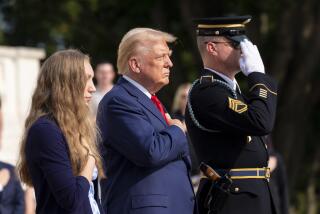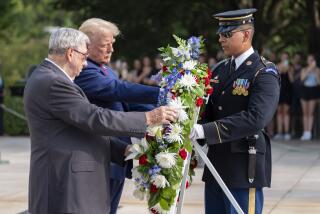A Memorable Visit to a War Heroâs Grave
He was just a memory, floating obscurely through the family, kept alive by reminiscences and yellowing black-and-white photographs in my grandparentsâ parlor. There was the typical family picture, my grandfather seated stiffly, my grandmother and their three children in a circle behind him. There were other pictures--confirmation, graduations from high school and college and, finally, the one in his uniform, looking so handsome, so proud, so young.
So when my husband and our son and I traveled to Italy, it seemed natural to take the short trip from Rome to the World War II American Military Cemetery at Nettuno to visit my uncleâs grave.
It was not a pilgrimage, just a gesture to my father to honor his brotherâs memory. I also hoped that the sight of those graves and the sacrifices they represented would have meaning for our teen-age son.
Drive Through Countryside
It was a quiet one-hour drive through the beautiful Italian countryside to the quaint resort town on the shores of the Mediterranean, a welcome break from the hectic sightseeing of Rome.
Driving through the large wrought-iron gates, down the drive lined with trees and hedges, we admired the beautiful expanse of lawns, gardens and crosses, thousands of crosses.
The American Battle Monument Commission maintains the grounds and provides an Army officer to assist visitors in finding graves. We trudged through each hedged-off section until we came to ours, then counted the white crosses and Stars of David, standing in perfect formation in every direction. Finally, one stood out, bearing the name of Edwin A. Bornander, Captain, 15th Infantry, 3rd Division. He had died Nov. 7, 1943, at the age of 26.
I was a baby when my uncle went off to war, but his memory in our family had been alive throughout my childhood, as had the legend of his death as a Silver Star hero. Kneeling to place flowers on his grave, I mourned.
I had wondered at the familyâs decision to bury him in this far-off land. My father had explained that poor transportation many times caused long delays for burials. Partly because Italy did not seem far away to my Swedish immigrant grandparents, but mostly because of my grandmotherâs failing health, the family decided to lay him to rest as quickly as possible in the cemeteries provided and recommended by our government.
Looking out at the well-manicured surroundings, I was satisfied they had made the appropriate, though difficult decision.
Other Graves
We looked at other markers, other names, other states, other dates. An Oklahoma boy in my uncleâs outfit was killed a day later, one from New York the day before. I wondered if they had known each other, were friends, had mourned each otherâs deaths.
We visited the memorial, a large, white marble statue of soldiers arm in arm, and a pavilion containing frescoes of maps with colorful arrows and dates showing the advancement of the armies fighting in Italy. As my husband and son traced the path of the 3rd Division, I listened to the birds, looked at the flowers and trees, tried not to see the crosses.
We were no longer in Italy. We were in an eternal, universal no manâs land, a facade of peace, of tranquility. Death and waste were buried deeply and all that showed were beauty, honor and valor.
Later, we picnicked on the beach at Anzio. We tried to picture the ships, landing crafts, armies of men, machine guns, explosions, foxholes and death we had seen portrayed in countless movies of this famous beachhead. But all we heard were sea gulls and lapping waves, all we saw were the blue-green Mediterranean and rolling, white sandy hills. Instead of spent shell casings, the quiet beach was littered with Coke cans and plastic bags floating in the breeze.
Several days later on a tour bus from the Isle of Capri, we passed Cassino, near the area where my husband and son determined Uncle Eddie was killed. The young Italian guide explained that atop the giant, flat Monte Cassino, which thrusts fortresslike straight up out of the hilly region, is the Abbey of St. Benedict, a 17th-Century monastery bombed by the Allies because for many months it had been used by the Germans to stop the march to Rome.
The decision to bomb had been a long, agonizing and controversial one. Before it was made, thousands upon thousands of men from all over the world fell in a deadlocked battle for this one small, isolated spot. Cemeteries honoring the war dead from many other countries are in this region. Families from Poland, New Zealand, India, France, Italy and Germany travel here to honor their fallen loved ones.
A Stark Statue
The German memorial to honor its 20,000 dead is stark, unadorned in glory. It contains only a metal sculpture of a man and woman, the woman bent forward in grief, the man standing tall with his hand on her shoulder--the parents of a soldier.
As the tour bus sped through the moonlit night on the road to Rome, the guide requested that each tourist sing a song from his country. He started with a rousing rendition of âO Sole Mioâ and was followed by a Japanese folk song. A French couple sang, then a man from Germany and a woman from South America. Finally, someone ended with âThe Yellow Rose of Texas.â


